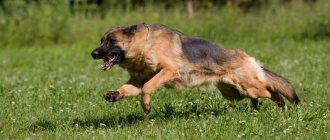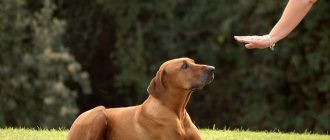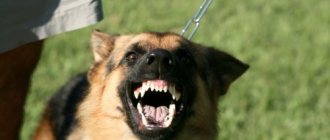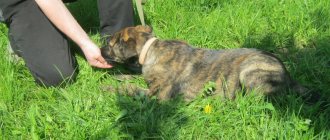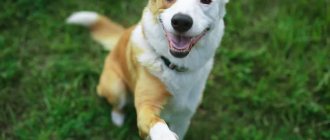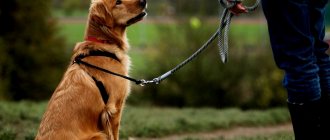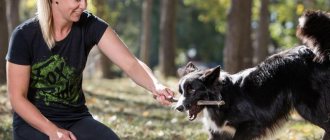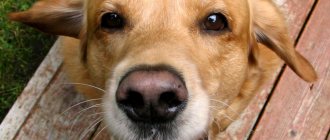Where is this command used?
The “place” command is not only a standard command for the general training course, but also an ordinary household command that owners often use in everyday life. Therefore, some dogs understand it perfectly and carry it out, while others get used to its constant repetition and simply ignore it. It depends on what the dog did after the place command, and whether the owner sought to comply with it or not. If he was satisfied that the dog simply moved away from him and did not interfere with him for a while, and he did not demand actual execution of the command, in this case the dog understands this command simply as a request to move away and not interfere. In any case, the dog is able to understand that at home the “place” command means to go to its specific place, if it has one, and on the street this command fixes as a place any object chosen to designate it.
Signs of anxiety
Quite often, even an adult dog, not to mention a puppy, noticing that the beloved owner is getting dressed, collecting things and going to the door, forgetting to grab the pet, falls into a panic. She begins to whine, bark, get underfoot, lie down on the threshold, blocking the way, and even grab her legs with her teeth. This is unpleasant and even dangerous - a young dog may well miscalculate his strength and injure his owner. And not every person can withstand the almost crying look of a dog.
However, this is quite natural - something worth understanding if you want to know how to train your dog to stay home alone. There is no need to worry, even if at these moments she shows certain signs of illness, such as a suddenly dry and warm nose. This is stress that can be easily eliminated with simple training. But first you need to understand why the dog shows its feelings so clearly.
The general principle of teaching the “place” command.
Teaching a dog the place command is quite simple if the dog is interested in food and the environment in which the training takes place allows the dog to concentrate on communicating with the trainer. There is such a thing as a comfort zone. In this case, this comfort zone is fixed by an object that is used to indicate a place. The comfort of this zone around an object denoting a place is created by the contrast that a person organizes and creates between the place and the rest of the space. The simplest thing is when, after the “place” command, the trainer praises, pets and feeds the dog lying in place, and outside this place he simply ignores it or forces it to go to place. There are three possible contrast options here. The first option is good on the spot, but neutral outside the place. The second option is neutral in place, but bad out of place. The third option is good on site, but bad off site.
What is important to know and take into account when teaching a dog the “place” command.
We begin training in familiar territory and in a situation where there are no strong irritants, namely other dogs, cats, family members who are bored and want to attract attention, etc. The so-called artificially depleted environment. The stimuli we use are food, leash jerk, intonation. The words we say are “good”, “well done”, etc. In addition to this, we need an object to mark the place, it is better if it is a rug with a pocket for treats. In addition, the dog must be in the right mood and state of activity. Before starting training, let's check the dog's food motivation by asking him to walk a few meters behind your hand, which contains food, and inviting him to put his muzzle in the pocket of the rug and take the food from there. It is very important that the dog is ready to actively obtain food; in this case, the trainer can only properly organize and play out the situation and everything will go like clockwork. Otherwise, it will be very difficult for the dog to focus on the object indicating the place.
Where should you start training this command?
The “Place” command in OKD is checked in conjunction with the “To me” command. But we will not alternate between calling the dog to us and sending it to its place. Moreover, when choosing the primary base link in the behavioral chain, we will focus either on moving to a place without laying down, or on laying down and staying in place without moving towards it. By making the task as easy as possible for the dog, we will give him the opportunity to successfully cope with the exercise and earn our approval and encouragement. Please note that it is very important to give the dog the opportunity to be successful, this creates a positive attitude towards training and in the future allows you to practice a lot and for a long time with the dog. Place a rug to mark the location on the ground. We take the dog by the collar with our left hand and stand so that the dog’s front legs are at the edge of the mat. With our right hand we take a treat from our pocket, bring it to the dog’s nose and drop it on the mat. If the dog is hungry, he will eat it as soon as you let go of the collar. It is important that the dog eats the treat directly from the mat after you remove your hand, and not from the hand that is placed down on the mat. This is a fundamental point, since in the future the dog will have to run to the spot at your command, and not look for food in your hand. If the dog does not take food from the mat, try a couple more times. If there is no result, then either she is distracted and the situation needs to be changed, or she is full and you just need to wait. There is no need to torture either yourself or the dog; just postpone the activity until the dog gets hungry.
When the dog begins to quickly rush and greedily eat the treat from the spot, we move on to the next stage of training. The starting position is the same as in the previous stage, but after you put the food on the mat, you need to move the dog back a little and after a pause of two or three seconds, release the dog to get the food. When teaching a command according to this scheme, there is no clear division between the stage of primary initiation of the basic element and the stage of specifying the desired behavior. We simply gradually increase the distance and change the direction from which we let the dog go to a place to eat food. When it becomes inconvenient to move the dog away, the distance is too large, we turn our backs to the place and lead the dog away, holding it by the collar. When leading the dog away from a place, it is important not to use coercion with a command or strict intonation. It is ideal when the soul of a dog is controlled by one, but fiery passion. To break through to the place, despite any obstacles and obstacles, that’s what she should want. If, at this stage, we force her to become obedient with a strict command “nearby,” then the conflict between the desire to eat food and the need to obey the person can reduce her motivation to perform the action being formed. Only when it is really difficult to physically lead the dog away from a place, does it make sense and is necessary to use psychological coercion by giving the command “nearby”. It is important to understand that there is a difference between moving the dog away from the place so that it is always in its field of vision or taking it away, turning away from the place. In the latter case, more interesting objects may come into the dog's field of vision, and it may switch to them. The trainer must understand this gradation of complexity, go through it consistently and gradually, and sincerely rejoice and praise the dog. Then the formation of behavior occurs very quickly. If the trainer begins to unreasonably complicate the dog’s task, then many dogs lose interest in such work. Only the hungry and concentrated continue to work as if nothing had happened. But domestic dogs do not always come to classes hungry. Many trainers believe that there is no need for a detailed breakdown into stages; it’s much faster to do everything at once. However, it is not. If everything is clear to the dog, it learns before our eyes, in real time, here and now. Those trainers who do not bother with consistent progress step by step, practice and practice, but their dog has never been able to consistently perform basic actions. It happens that people practice the “place” command with their dog for two months, and the result is very pale. It is important to know that if the technology is followed correctly, dog training occurs very quickly, literally before our eyes. If this is not the case, then something is being done wrong.
Another sequence for teaching a dog the “place” command.
It is possible, and in some respects even more correct, to choose as the primary link not the movement of the dog into place, but the laying of the dog in place. How it's done. We place the dog on the mat so that the pocket with food is located between its front paws. In this position it will be convenient for the dog to eat food from the pocket. While the dog is eating food, the trainer strokes it, pats it on the withers with his hand and sometimes presses it in place, fixing it by the withers, but not by the neck. At the same time, you need to say the commands “place” and “lie down” in a gentle intonation. It is important that in this generally very pleasant and positive situation of eating food, elements of coercion are unobtrusively present in the form of patting with a hand and fixing the withers with such intensity that the dog is ready to endure them and not resist. We do this exercise several times, alternating between lying in place and walking on a leash within a radius of five to six meters. Every time the dog lies still, he eats food from the pocket of the mat, and not from the handler's hand. When a dog walks near a place on a leash with its owner, there should be no distractions. The dog should wait for work and rejoice when it is again brought to the place, laid on it and fed. This, of course, will not happen if you allow the dog to do something interesting during the break between putting it down. There is no need to force the dog to go to the place. It is enough just to calmly approach him. A hungry dog will soon begin to drag you to this place. To do this, it is useful to leave the food in the pocket of the mat when taking the dog away. It is important how the dog perceives this situation and what it wants now. Your goal is for the dog to develop an independent desire to move to a place, lie down on it and eat food. If you do this exercise formally, not paying attention to the fact that your dog is well-fed, is distracted by other dogs, and you are actually forcing it, then the result will be the opposite. In her perception, training will compete with more interesting activities.
Regular walks
Quite often, people who do not devote enough time to their pet have to find a way to train an adult dog to stay home alone. Because you are so busy, you have to hastily walk the dog, spending only a few minutes, and sometimes skipping this most important and favorite activity. Would you like it if you were deprived of your bonus without explanation at the end of the month?
Therefore, try to walk your dog at the same time, and for as long as possible. If possible, let the dog run around to its heart's content, play with friends, and not just obediently follow you on a leash.
Active rest will allow your pet to throw out maximum energy, and when he comes home, he will first of all try to eat and go to sleep, and not worry about the fact that his owner left him for a long time.
And just regular walks without passes allow the dog to be confident in the inviolability of the established world. Therefore, she will react much more calmly to the fact that after a long walk the owner leaves her alone at home, and almost immediately after returning they will take a walk together in their favorite park.
A few words about a tougher approach to practicing this command.
Of course, it is possible to start learning this skill right away with harsh coercion. In this case, such coercion is necessary so that the dog forgets about other interests. The main thing she should think about is what needs to be done to avoid pressure and correction. The trainer must technically work in such a way that the dog very quickly understands that correction can only be avoided by lying still, that is where the saving comfort zone is, there is no other way out. An ordinary dog owner cannot do this; he is not ready to work like that. Since the dog is a family member for him, and not an object of influence.
Busy evenings and weekends
Finally, the question of how to teach an adult dog to stay alone at home is often asked by owners who do not pay enough attention to their pet. Remember - it is in you and your family that the whole meaning of the animal’s life is concentrated. For him, you are alpha and omega, the beginning and the end, practically a god.
Pamper him more often, spend as much time with him as possible. An excellent choice would be a regular walk, a joint evening jog (you can ride a bike, matching the dog’s running), and a variety of games.
It is thanks to such a rich life that the dog feels loved and will be much easier to endure separation.
